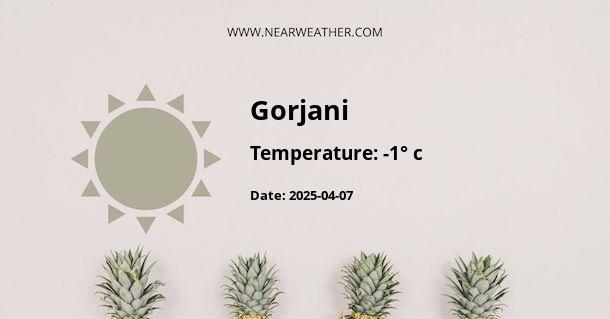Understanding the Climate and Weather of Gorjani, Croatia
Gorjani is a village located in the eastern part of Croatia, within the region known as Slavonia. Like much of continental Croatia, Gorjani experiences a moderate continental climate, which offers four distinct seasons with variations in temperature and precipitation levels throughout the year. In this piece, we will delve into the climatic nuances of Gorjani, explore monthly weather patterns, and highlight meteorological phenomena peculiar to this region.
Climatic Overview
The climate in Gorjani is characterized by warm, humid summers and cold, snowy winters. Transitional seasons, spring and autumn, typically feature mild and variable weather. The continental influence implies greater temperature extremes when compared to Croatia's coastal regions.
Temperature Patterns
Temperature variations are significant over the year. Summers in Gorjani can become quite hot, with July being the warmest month, whereas winters are brisk and cold, with January often being the coldest month. Below is a table illustrating the average high and low temperatures throughout the year:
| Month | Average High (°C) | Average Low (°C) |
|---|---|---|
| January | 2 | -4 |
| February | 5 | -2 |
| March | 11 | 1 |
| April | 16 | 5 |
| May | 21 | 10 |
| June | 24 | 13 |
| July | 26 | 14 |
| August | 26 | 14 |
| September | 21 | 10 |
| October | 15 | 6 |
| November | 8 | 2 |
| December | 3 | -3 |
Note that these temperatures are averages and can vary from year to year. It is also not uncommon for heat waves to push summer temperatures higher, while cold spells can lead to even lower winter temperatures.
Precipitation and Humidity
Overall, Gorjani experiences a fair amount of precipitation scattered throughout the year, with a slight peak during the late spring and summer months due to convective rainfall. Snowfall is common in the winter, especially from December to February. The table below presents the average monthly precipitation and humidity levels.
| Month | Average Precipitation (mm) | Average Humidity (%) |
|---|---|---|
| January | 40 | 87 |
| February | 35 | 83 |
| March | 40 | 78 |
| April | 50 | 73 |
| May | 60 | 73 |
| June | 80 | 74 |
| July | 70 | 71 |
| August | 60 | 73 |
| September | 70 | 78 |
| October | 60 | 82 |
| November | 70 | 86 |
| December | 50 | 88 |
Humidity can play a crucial role in how temperatures are perceived, with higher humidity levels often making the air feel more oppressive during the summer and cooler in the winter due to the wind chill factor.
Wind Conditions
Wind conditions in Gorjani can vary, influencing the perceived temperature and comfort level. The region experiences a variety of wind systems, including the Bura, a dry, cold wind from the northeast, and the Jugo, a warmer southeasterly wind known to bring moisture and sometimes precede stormy conditions.
"Wind conditions can significantly affect the microclimate of a region, altering temperatures, precipitation patterns, and even impacting agricultural practices," notes Dr. Ivana Vlahović, a prominent Croatian meteorologist.
Extreme Weather Events
While Gorjani generally has a temperate climate, extreme weather does occur. The country can experience severe thunderstorms, particularly in the summer, and droughts have also been known in the region during periods of prolonged low precipitation. Winter brings its hazards, with snowstorms capable of disrupting transport and infrastructure.
Seasonal Analysis
- Spring: An increase in temperature and daylight hours with variable weather. Precipitation in the form of rain and, early in the season, snow, is common.
- Summer: Hot temperatures, high humidity, and periodic thunderstorms. Occasional heatwaves can push temperatures above 30°C (86°F).
- Autumn: Cooling temperatures, decreasing humidity, and an increase in precipitation. This is often seen as the most comfortable time of year, weather-wise.
- Winter: The coldest season with snowfall, ice, and sometimes challenging weather conditions including fog and freezing temperatures.
Climate Change Considerations
It is important to consider the impacts of climate change when discussing weather patterns. Data suggest that the frequency and intensity of extreme weather events are likely to increase. Warming trends may result in milder winters and hotter summers for regions like Gorjani, influencing everything from agriculture to water resources.
Conclusion
Gorjani, Croatia, with its continental climate, showcases a diverse array of weather conditions throughout the year. From warm summers to cold winters, precipitation patterns that range from snow to heavy thunderstorms, and the impact of persistent wind systems, the region exemplifies the complex interplay of meteorological forces. As global climate patterns shift, monitoring such regions becomes increasingly important to understand and predict the changes that lie ahead.
Please note that the data provided in this analysis represents averages and historical patterns, whereas actual conditions can vary and should be confirmed with up-to-date local weather forecasts and climate models.
A - Gorjani's Latitude is 45.398891 & Longitude is 18.372219.
A - Weather in Gorjani is 14° today.
A - Climate Conditions in Gorjani shows scattered clouds today.
A - Humidity in Gorjani is 65% today.
A - Wind speed in Gorjani is 6.44 km/h, flowing at 68° wind direction. today.
